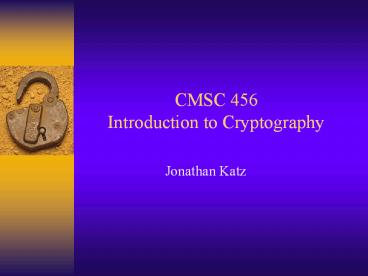CMSC 456 Introduction to Cryptography - PowerPoint PPT Presentation
Title:
CMSC 456 Introduction to Cryptography
Description:
CMSC 456 Introduction to Cryptography Jonathan Katz – PowerPoint PPT presentation
Number of Views:259
Avg rating:3.0/5.0
Title: CMSC 456 Introduction to Cryptography
1
CMSC 456Introduction to Cryptography
- Jonathan Katz
2
Overview of exam
- The exam is cumulative
- More emphasis on material covered in the second
half of the semester - Focus on understanding and application, less on
being clever - Please read instructions, and describe attacks or
constructions clearly and unambiguously
3
Chapter 1
- Historical private-key encryption schemes
- Why did we talk about these?
- Modern cryptography
- Definitions
- Assumptions
- Proofs
4
Chapter 2
- Perfect secrecy
- The one-time pad
- Limitations of perfect secrecy
- Key as long as the message
- Key can only be used once
- No security against chosen-plaintext attacks
- Need pre-shared key!
5
Chapter 3a
- Computational security
- Private-key encryption
- Definitions
- Indistinguishability in the presence of an
eavesdropper - Multiple-message indistinguishability
- CPA-security
- CCA-security
6
Chapter 3b
- Primitives
- Pseudorandom generators
- Pseudorandom functions (block ciphers)
- AES, 3DES, (DES)
- Encryption schemes
- Pseudo one-time pad
- Deterministic encryption?
- Basic CPA-secure encryption scheme
- Modes of encryption
7
Chapter 4a
- Message authentication codes, defining security
- Collision-resistant hash functions
- SHA-1
- Birthday attacks (other applications?)
- Constructions
- Basic construction for short messages
- HMAC
- CBC-MAC
8
Chapter 4b
- Privacy message authentication, CCA-security
- Encrypt-then-authenticate
- Why are the other alternatives problematic?
9
Chapter 5
- Definition of pseudorandomness
- Concrete security requirements
- Substitution-permutation networks
- Attacks on reduced-round SPNs
- AES
- Feistel networks
- Attacks on reduced-round Feistel networks
- DES
- Increasing key length
- 3DES
- Meet-in-the-middle attacks
10
Chapter 7
- Modular arithmetic, group theory, cyclic groups,
generators - ZN, ZN, ?(N)
- Generating random primes
- Factoring assumption, RSA assumption, discrete
logarithm assumption, Diffie-Hellman assumptions - One-way functions, examples
11
Chapter 9
- What are the limitations of private-key crypto?
- Why did we bother studying private-key crypto at
all? - Key exchange
- Definition of security
- Diffie-Hellman key exchange
12
Chapter 10a
- Public-key encryption
- Definitions
- Indistinguishability CPA-security
- Deterministic encryption?
- CCA-security
- Why important
- Hybrid encryption
13
Chapter 10b
- RSA encryption
- Textbook RSA
- Why is it insecure?
- Padded RSA
- El Gamal encryption
- What assumption is it based on?
14
Chapter 12a
- Digital signatures
- Advantages relative to MACs?
- Definition of security
- RSA signatures
- Textbook RSA
- Why is it insecure?
- Hashed RSA
15
Chapter 12b
- Hash-and-sign
- 1-time signatures, Lamports scheme
- PKI, certificates
16
The real world
- Pseudorandom functions (block ciphers)
- AES, 3DES
- Collision-resistant hash function
- SHA-1, others (NIST competition)
- Private-key encryption
- E.g., CBC mode, others for CPA-security
- Encrypt-then-authenticate for CCA-security
- Message authentication codes
- HMAC, CBC-MAC, others
17
The real world
- Key exchange
- (Authenticated) Diffie-Hellman
- Public-key encryption
- (Variants of) padded RSA
- El Gamal encryption
- CCA-secure schemes
- Signature schemes
- (Variants of) hashed RSA
- DSS (we did not cover)

